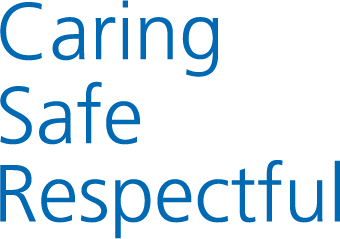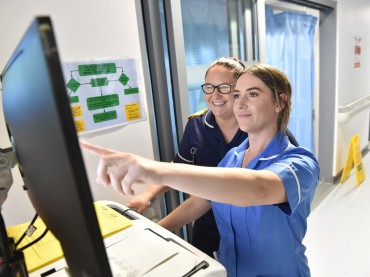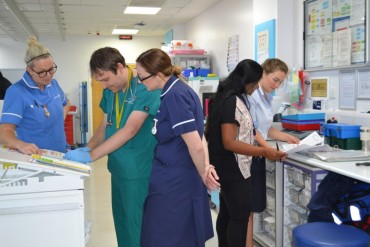Parenteral Nutrition
You have been referred for Parenteral Nutrition (PN), sometimes referred to as TPN (Total Parenteral Nutrition). This leaflet will help you to understand what this is and how it may affect you. If you have any other questions, please do not hesitate to ask the medical, nursing, dietetic, pharmacy staff or members of the Nutrition Support team (NST) who have been asked to see you.
The Nutrition Support Team (NST)
The NST will come to review you every day during the week. The NST will also liaise with your medical and nursing team to ensure all your nutritional requirements are met.
Members of the NST:
• Consultant Gastroenterologist
• Nutrition Nurses
• Specialist Dietitians
• Specialist Pharmacist
• Specialist Speech and Language Therapist
What is Parenteral Nutrition?
Parenteral Nutrition (PN) is an artificial way to give your body nutrition and hydration, when you are unable to eat and drink enough to maintain your weight and hydration normally, or when you are not able to absorb enough nutrition from food and drink.
PN is only considered when you cannot obtain all the nutrition you need by other routes i.e. by mouth or enteral tube feeding via the gut. At the moment, we are unable to access your digestive system safely to provide adequate nutrients, that your body needs to keep healthy.
PN is a liquid that contains all the nutrients that your body needs; calories (from sugars and fats), proteins, vitamins, minerals, electrolytes (salts) and fluid. Your nutrition team dietitian will calculate how much PN you will require. All the nutrients you require go directly into your bloodstream thus bypassing your gastrointestinal system (stomach, small bowel, large bowel). The benefit of PN is that it will provide some or all the nutrients your body needs to optimise your nutrition and heal.
How will I receive Parenteral Nutrition?
Initially your PN may be given via a peripheral cannula in your hand or arm. Sometimes you will return from theatre with a line in your neck which we are able to use to administer your PN for a period of time.
If you remain on PN we may need to refer you for placement of a more permanent line called a PICC line. This line would be placed by a specialist team under local anaesthetic and you do not need to be put to sleep. This will sit in your arm and can stay in place for a longer period of time. It is important that you do not touch the line as this can lead to infection.
Who will care for my line?
Your line will be looked after by nursing staff who have had special training to manage the line you have. This may mean staff from another area in the hospital coming to start and stop your feed, depending on which ward you are on. A member of staff who has not been trained to look after these kinds of lines would not have access to it. If there are any concerns, please request to speak to the nutrition specialist nurse or any member of the NST.
How long is the PN attached for?
To begin with, PN will be given continuously over 24 hours. We cannot disconnect and reconnect the line once your PN is running due to the high risk of infection. Once the bag is started, it will stay up until it finishes. You will be able to move around as the pump and feed will hang on a mobile stand.
Once you reach your target feed and are stable on it, the amount of time it needs to be given over may be reduced. The PN will provide the same nutrition, but over a shorter period of time to allow your liver a rest. This will also give time off being attached to the drip. If you are on PN long enough, we will aim to have the feed running overnight so you are free in the day.
Will I be able to take a bath or shower?
We usually advise patients to aim to have a wash or change of clothes at the time their bag of PN is due to be changed, this is usually early evening. You will be able to have a wash or shower but avoid getting the catheter or dressing too wet in the short gap of time before the next bag is attached.
What are the risks of Parenteral Nutrition?
The main risk is infection of the line which the nutrition is given into. To reduce this risk, it is important to avoid touching or handling the line unnecessarily. Your temperature and the site where the line is inserted will be checked regularly for signs of infection.
If you notice you have any of the following symptoms, please report to the nursing team:
• A high temperature
• Shivers when line is flushed
• Line site becomes red
• Line site swollen or painful
• If you notice discoloured fluid from the site
Your blood sugars levels need to be monitored closely whilst having PN as there is an associated risk of your blood glucose levels becoming too high or low. This will be done by regular finger prick blood tests four times a day, even if you aren’t diabetic.
You will need to have blood tests; usually daily when you start PN as this is important to ensure that your salts (electrolytes) included in the PN are the right amount for you. There is a risk of these levels becoming deranged however they will be closely monitored and corrected as needed.
If you require PN for a longer period there is a risk of liver dysfunction, your liver function will be regularly monitored on your blood tests.
This monitoring is required to minimise the risks and when you are stable, on the appropriate PN regime, the NST will aim to reduce the frequency of the bloods and blood sugars, when safe.
Can I still eat and drink whilst on PN?
This depends on several factors. The team looking after you will discuss this with you and if they are happy, your dietitian can advise you on the types of food and drink that would be suitable. Your mouth will feel dry, so it is important to ensure regular mouthcare.
Will my bowel habits change?
PN goes straight into the blood stream, but you will still produce bowel movements from mucus, cells and bacteria. PN should not cause diarrhoea, vomiting or pain.
How long will I need to have PN?
This depends mainly on the primary reason why it was initially recommended. In some cases, you might only need PN for a short time, until your gut begins to function and/or when you are managing oral intake or enteral nutrition sufficiently. On the other hand, it may be needed long-term. The medical team and NST looking after you should be able to provide a more detailed insight as to how long you might need this type of feeding.
Can I withdraw my consent to PN?
The NST would explain the risks and benefits of parenteral feeding to you prior commencing treatment. You have every right to consent to feeding or withdraw consent if you are not comfortable with commencing this type of feed. If there are any concerns or if in need of further clarification, please request to speak to the members of the NST for further advice and guidance.
It is important that you let a member of the NST know if you have any food allergies to nuts, eggs, fish or anything else.
Questions
Please use this space to write down any questions you may have for the Nutrition Support Team:--------------------------------------------------------------------------------------------------------------------------------------------------------------------------------------------------------------------------------------------------------------
Leaflet Number PL/1605 (V2)
Author Emily Whitaker / Precious Maduabuchi
Review Date 01/02/2028



